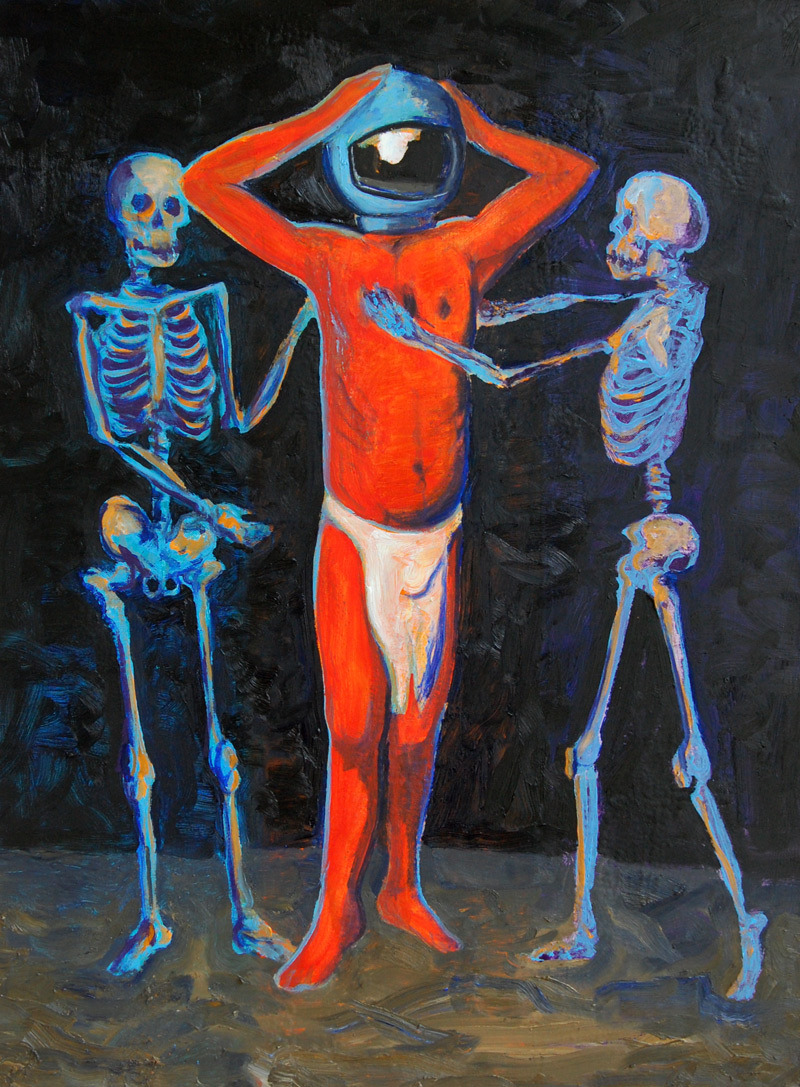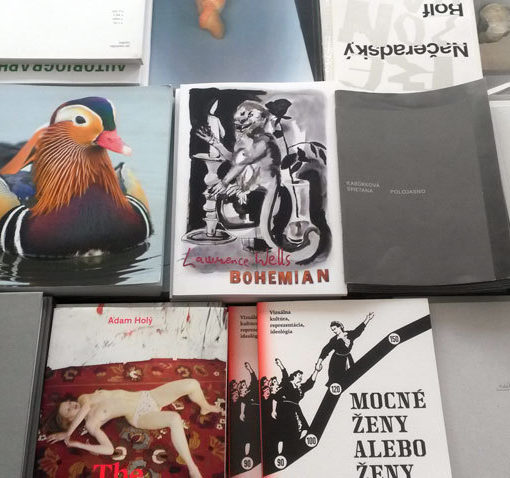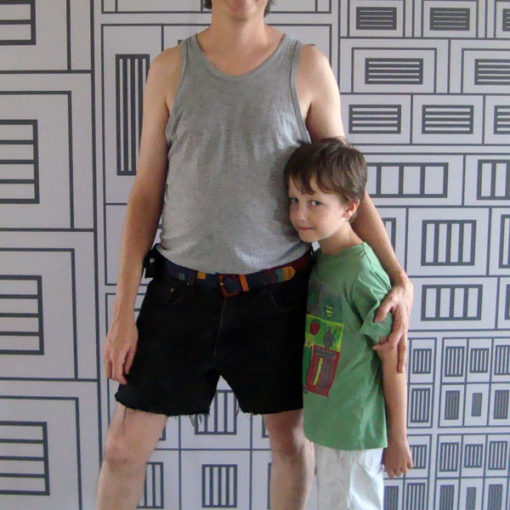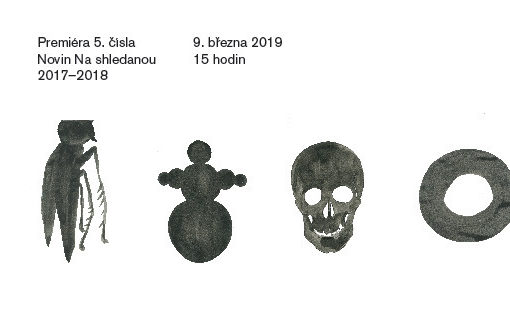Enter the Far Off Universe of Lawrence Wells
Moon Unit, Wells’ Tumblr
(pictured above: Astronaut and Candle, 45 x 60 cm, Spray paint, enamel and oil paint on canvas, 2011)
HM: We noticed that you were from the Czech Republic but did most of your formal studies in the US, in MS and IN… . how do you feel that education reflected on your work and your progress as an artist? Did you have a reason to go to the US other than to study art? We’re just curious about your journey and discovery.
LW: I’m not Czech actually. I am an American expat and I have lived in Prague for over ten years now. I studied painting in Indiana where I got my BFA and in Mississippi where I graduated with an MFA in 1992. I’m 46 and have been painting for around 25 years, but I feel that only in the last few years has the work started coming together more. One reason that I chose to become an artist is that it is a field that is always changing, one is constantly growing as an artist, and I like that. It’s not over till it’s over, if you know what I mean. I moved to Prague from New York just before 9/11. I’d been here before in the early 90’s and I missed it, plus I found it hard to produce work inNew Yorkwhere its just too stressfull. But now I miss New York too .. haha
HM: We are quite amazed by the volume of work that you produce and publish, how often do you paint and how often do you complete a painting? We notice that many paintings carry on the same themes almost as evolving narratives starring your favorite characters, is this true?
LW: Thanks for the compliment. I try to get over to the studio as much as I can. I used to work more slowly, but I realized that one can’t be too precious about the work and also thinking too much just spoils it.
I try to maintain a thread through the work, one piece leads to another. I started working with the theme of astronauts and Indians last year (2011) when I got my new studio. I had started writing a novel for Nanowrimo the year before about Indians on the moon and images from that were still floating around in my head. I wanted to turn away from the type of work I had done in 2007–2008 which was more about my reactions to living in the Czech Republicand had focused on history and a kind of faded dream of the fin-de-siecle, which one can feel very strongly here. In the new work I wanted to be much more colorful and juicy, as a kind of opposite reaction to the gray skies of Central Europe.
“Painting is a kind of unveiling, or a sort of dreaming, and I want to find the symbols, colours, and surfaces which resonate with the viewer in such a way that he/she can’t define or know.”-Lawrence Wells
HM: How do you come about choosing the characters to represent and their stories? We will point directly to your series including astronauts and candles which we have posted on hyperreal.me? There seems to be many others including Indians, skeletons, astronauts, cupids, and melting candles… .With the interaction of these characters with color and symbols do you intend to create a metaphor or even a prolonged narrative?
LW: I don’t mean for the narrative between these various characters to be clear or direct. I don’t even know myself and I think that’s important. Painting is a kind of unveiling, or a sort of dreaming, and I want to find the symbols, colours, and surfaces which resonate with the viewer in such a way that he/she can’t quite define or know. In this way the painting becomes a cipher that hopefully nags at the viewers memory, that calls forth a sympathetic response.
Painting is an extremely slow medium in the sense that unlike film the image doesn’t move, so art is fundamentally about a feeling of mystery, or an unresolved tension, that evokes feelings within the viewer. In that way one lives with a painting and meditates on it. That is the power of the single image or of the painting as an object.
I was thinking of the astronaut as a kind of tragic figure, in a sort of retrofuturist way. Retrofuturism is a kind of hauntological attitude to the lost dreams of the past, and I do feel that the space program is basically dying and that the journey to the moon will come to be like an ancient myth. In this time of resource depletion and late capitalist turmoil, I sincerely wonder if we will ever send another man into space, or at least out into space as an explorer. It’s a symbol of the end of manifest destiny. And so in this way the astronaut becomes an endangered figure, like a brother perhaps with the native, with the so-called indigenous peoples. With our technology we have become divorced from nature and the Western/European response to the Other has always been a loaded one, loaded with colonial or romantic Rousseauian projection. I can’t help but be caught up in that historical process, but I feel like the planet is in crisis and if we don’t learn to live together with all our differences, then we are lost and our Enlightenment project will come to nothing. Perhaps we should ask if we are so enlightened, then why does our society still rely on leveraging cheap labour in “third world” countries?
Musical Interlude, acrylic on paper, 70x70cm, 2011
So the relationship of the indian with the astronaut is fraught with difficulties and I think we all know that, at least at a subconscious level. Of course it’s complicated for me as a white suburban guy from Kentucky transplanted to Prague to approach the image of native peoples. Some people will always be offended by appropriation, they would feel that my use of these figures, for example, is only a part of the continuing colonial discourse. In response I can only suggest that we share each others’ stories and we are enriched by the wide variety of cultures and dialogues that springs from this relationship. If we only focus on ideas of “authenticity” or “identity politics”, then we continue to be trapped in opposing camps. I’ve always felt that the artist’s role is to go into the danger zone and to take risks. The risk I take is that I will only reinforce stereotypes through the work, like with loin cloths/feathered headdresses, and so on. I suppose living in the Czech Republic I felt that I could more comfortably approach this type of imagery, without worrying about being politically correct.
As an American here I’m an outsider so I can deal with this topic with perhaps a bit more authority than a Czech painter, nor do I think Czech painters are interested in this theme anyway. My work is about America, because I realised as a foreigner that I would always be defined by my nationality. Living here I have the space to see the country and its history from a distance. And I also think I’m drawn to the lives of indigenous peoples because they belong to a tribe, whereas I have become a man with no country in some regards. Art is about the visual, and representational art is bound to have some political or psychological relationship with the surrounding culture.
HM: If there is a narrative, such as in the Astronaut and Candle paintings, what is that story?
LW: In some ways these works are all memento mori, reminders of death. As I said the astronaut is endangered too, our way of life is in trouble. The candles represent a kind of phallic energy, but they also represent time, so our time is running out. They stand, like the figures, as a kind of witness. But lately I’ve moved away from combining all these symbols together and am focussing on working with the tropes individually, so in an exhibition setting the paintings can play off of each other.
Touch of Death, Oil on canvas, 70 x 95cm, 2011
HM: We were introduced through a brief discussion about Fritz Scholder, which we are also a big fan, there appears to be a strong influence here from his work. Did his work have a lasting influence on you, is that one reason you use Native American imagery? But more than the figures, it is the boldness of blocked color, softening edges, and ghostly appearance of light that makes us notice a connection, what do you think?
LW: I was already painting native Americans when I discovered his work, but what I really like about it is his use of color and the way the figures stand and look at the viewer. This is something I’m doing in my work as well. Scholder studied under Wayne Thiebaud and his work is like an amalgam of Thiebaud’s use of color and Francis Bacon’s approach to the figure. There were many artists across the States working in a similar way to Scholder in the 60’s and 70’s and this shows that art was still functioning on a social level. It was the end of movements and although I think there are some great artists working today, I think our culture is more and more fragmented. That’s not necessarily a bad thing, but I heard Erik Davis on his podcast Expanding Mind the other day refer to our time as “the twilight of the analog” which I think is such a good turn of phrase .. in a sense the analog is dying off and painting is the ultimate form of that kind of hand-crafted object. It will never disappear altogether. In fact the future may very well see a return to the tribal, with all the localised art-making and self-modification that entails. The analog could come back in a big way.
Fritz Scholder, Indian with a Beer Can, Oil on Canvas, 1969
HM: Being a huge fan, we really enjoyed your insight on Scholder and the article you sent me titled “Who’s Afraid of Fritz Scholder,” by Paul Chaat Smith. It discusses Scholder’s many contributions as a prominent American artist but shows how he was instead cast off only as an Indian Artist by most critics. We think that this is a great topic for discussion as we enter a more connected world where real-world locations may be loosing power to the Internet.
HM: Do you have any upcoming shows or projects you are working on?
LW: I have a show lined up in September at a small gallery in Litoměřice, a town north of Prague. It’s an old Gotrhic interior apparently with vaulted ceilings and I’m looking forward to seeing my new work on display. I’ve shown in cafes in Prague but the scene is pretty small here. While I have the studio I just want to produce as much as I can and hopefully expand my career.
HM: What is the art scene like in Prague and the Czech Republic? What is your favorite art hangout or art venue in your city?
LW: Considering the size of the scene (Prague has about 1.5 million inhabitants), there are a number of exceptional artists here. The Czech Republic has always been overshadowed culturally by their big neighbour, Germany, and Prague doesn’t hold a candle to Berlin, for example. But the power of these small countries in Europe with their long history can’t be denied. A lot of painters here are dealing with different ways of applying paint, using drips and stencils, etc, and some of that way of working has rubbed off on my approach.
The coolest art scene here, at least in terms of an underground vibe, is around the A.M. 180 collective and their gallery space in Klub Utopia. The brother/sister team who set up the space are inspired by indie culture and the LA/Brooklyn/Williamsburg/London/Berlin art axis. They also put together a summer music festival called Creepy Teepee which is held in Kutna Hora. Highly recommended.
“But generally my approach is pretty traditional, just brushes on canvas.” -Lawrence Wells
HM: Do you use any digital devices or technology to create or influence your work?
LW: I sometimes cut stencils for my work, but it’s all done by hand. I’ve played around with trying to make some 3D animation based on my motifs, but its hard to find the time. So much work nowadays is complimented by video, sculpture and performance and I gave some ideas along those lines. But generally my approach is pretty traditional, just brushes and canvas.







